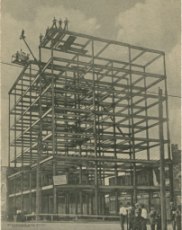Impact of electricity for construction equipment
 A number of new problems put before the construction of widespread use of electricity. Implementation in 1882 by Frenchman M. Despres DC transmission on the bare wire at 57 km set the task of construction of masts of at least 20 meters high, quite hard vertical and steady in the direction perpendicular to the arrangement of wires.
A number of new problems put before the construction of widespread use of electricity. Implementation in 1882 by Frenchman M. Despres DC transmission on the bare wire at 57 km set the task of construction of masts of at least 20 meters high, quite hard vertical and steady in the direction perpendicular to the arrangement of wires.
In 1891, Russian engineer MO Dolivo-Dobrovolsky a transition from DC to AC. As a result of increased electric current transmission distance of 170 km, and the construction hydroelectric rivers width greater than 300 m of water pressure above 15 m. To concentrate the pressure in one spot, required except dam also discharge device in the form of open channels or tunnel, as well as the construction of the reservoir. There was a need for concrete strength above 300 kg / cm2 and at a rate of hardening of cements, measured not in weeks and days. Vladimir G. Shukhov (1853-1939 biennium).
Achievements in the field of electricity and electrical engineering have enabled wider and more effective use in the construction of metal structures. Of great importance was the discovery and use in construction of electric welding, which was quickly replacing traditional methods of combining the elements and structures of nodes - riveting and forge welding.
Studies conducted in 60-ies of XIX century. arsenal in Vulvichskom (England) showed that if the seam strength. performed by forge welding, resistance is a solid iron sheet, the riveted seam, it is only 0.6 of this magnitude. Welding, electric, lighter and easier to forge, made it possible to obtain a compound which not only reduced the coefficient of the weld line strength, but even increased it to 140% resistance to the base metal. With the introduction of Electric eliminated the need for overlays and rivets, whereby the weight of metal structures could be reduced to 50%.
Of great importance in the progress of the construction has been the spread of electric lighting, which replaced gas lighting. Especially important was the searchlight shape - floodlight system in which on special mast height of 15-30 m 6-12 lamps strengthen the capacity of 500-2000 watts. The introduction of this system has allowed the clock to conduct the construction work, which had previously always performed only in the daytime.
Progress in the field of electricity has affected a number of other issues are inextricably linked with the construction technique. One of them - use the recycling heat steam-turbine power plants. Resolution problem removal of huge quantities of hot condensate water from power plants opened up the possibility of using it for heating of industrial and residential buildings. The result was the beginning of the construction of large power plants combined, produce not only electricity but also heat in the form of hot water and steam.
The use of electricity has had an enormous impact on the construction of multi-storey buildings, which largely contributed to the development of electric drive technology based ventilation and water pumping facilities.
The electric motor is delivered by the fan associated with the use of a pair Group remennoshkivnoy transmission and provided an opportunity to put it into any desired operating conditions at the building. In addition, sharply increased the effectiveness of the ventilation equipment fitted with an electric drive. If the vapor pressure of the drive has reached the maximum 5 to 10 mm of water. Art. and the performance does not exceed 1700 m3 / min, the electrical ventilation systems allowed to increase the pressure to 100 mm of water. Art. with a capacity of up to 2800 liters 3 / min.
Similarly was the result of the application running in the water supply of the electric motor-speed centrifugal pumps. If steam piston pumps at a maximum shaft speed of 300 rev / min could raise water to a height of not more than 50 m, the electrical installation has improved the speed of up to 750, 1000. 1500 and 3000 rev / min and a pressure of up to 60-100 m. This was achieved water supply high-rise buildings, the construction of which was initiated in 1893 the construction of 20-storey building in Chicago.
In addition, the construction machinery itself has had a big impact on the power industry. For example, concrete has expanded the possibility of building huge dams for hydroelectric power plants. The largest was the construction of the dam Keo Cook, built in 1912 on the Mississippi River. The dam has a length of 1410 m. The width at the bottom 13 m height above the water level 13 m possessed spillways metal gate, controlled by electricity from the station building. It caters to the installation capacity of 200 ths. KWh and passed an electric current in the city of San Luis at a distance of 272 km.
No less important role played by the progress of steel structures in the development of power transmission over long distances, as well as radio, who presented the demand on power grids and high antenna mast.
S. Shukhardin "Technology in its historical development"



Comments
Commenting, keep in mind that the content and the tone of your messages can hurt the feelings of real people, show respect and tolerance to his interlocutors, even if you do not share their opinion, your behavior in terms of freedom of speech and anonymity offered by the Internet, is changing not only virtual, but real world. All comments are hidden from the index, spam control.